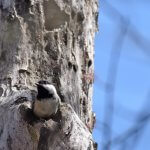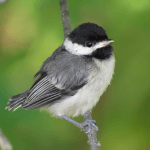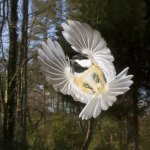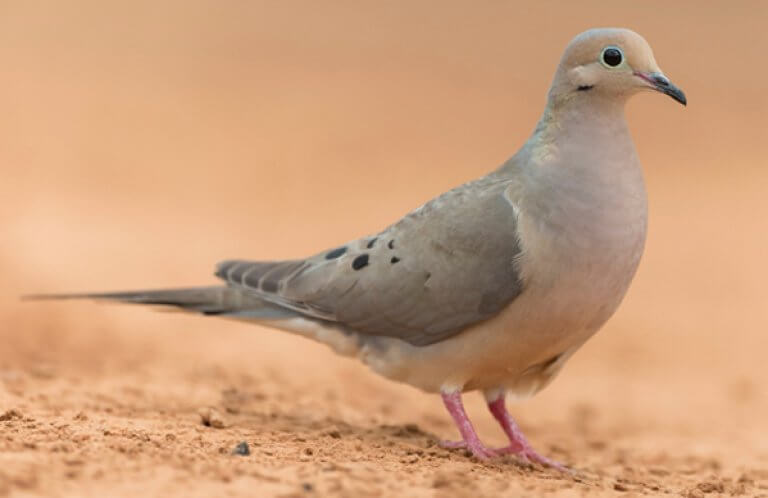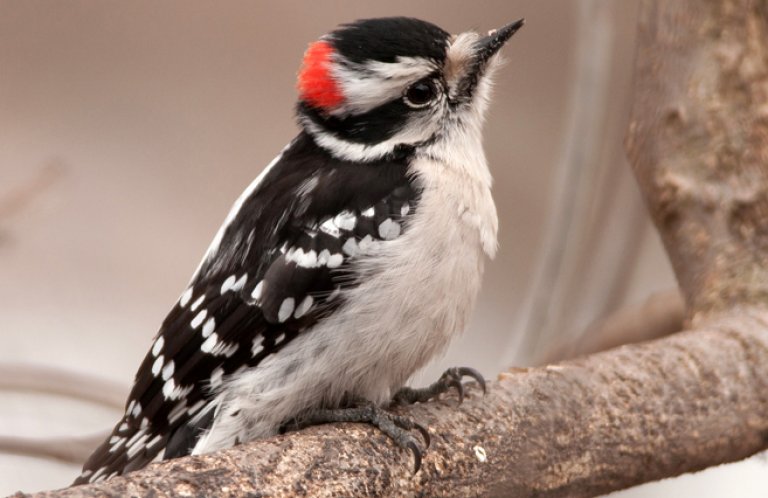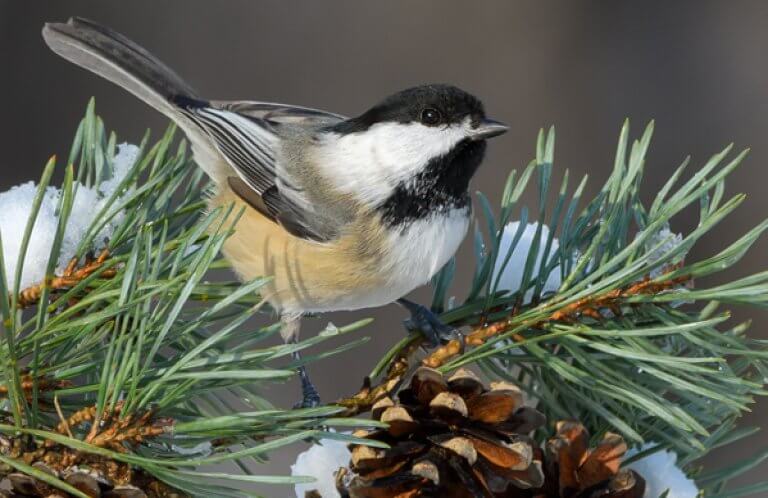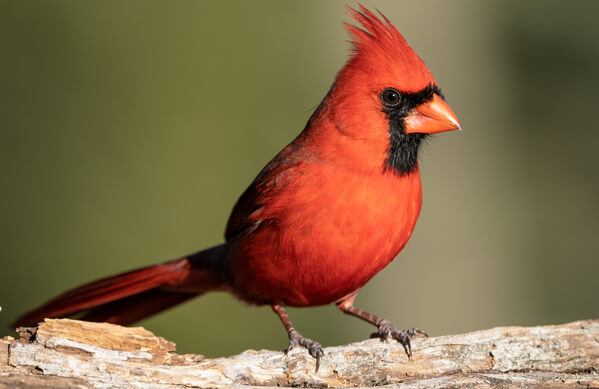About the Carolina Chickadee
The Carolina Chickadee is endemic to the southeastern United States, where it is a common backyard visitor, along with the Blue Jay, Mourning Dove, and Downy Woodpecker. Although this perky, black-capped and -bibbed songbird is adaptable, recent studies reveal it is also choosy, seeking out suburban nest sites where certain kinds of plants grow.
Seeking Native Plants
For successful nesting, Carolina Chickadees need to gather large numbers of caterpillars and other invertebrates to stuff in the gaping mouths of their fast-growing young. Unfortunately, many suburban backyards prove to be "food deserts" for these birds. This is because many properties are landscaped with non-native trees and shrubs upon which few native invertebrates feed. A recent study indicates that Carolina Chickadee pairs in the Washington, D.C., area only bred successfully in suburban yards with a biomass of at least 70 percent native plants. Researchers noted how the birds avoided non-native plants, and prioritized visits to native oaks and other trees known to harbor large quantities of caterpillars. It's easy to understand why these little birds are so selective, if you consider that during their nestling period (16-19 days), one Carolina Chickadee pair was observed feeding their brood 6,000 to 9,000 caterpillars.
Songs and Sounds
Chickadees are named for their calls. The Carolina Chickadee's "chickadeedeedeedee" is faster and higher pitched than that of its very similar northern and mountain cousin the Black-capped Chickadee. The Carolina also has a distinctive song, a sweet-sounding "feebee, feebay." Foraging birds also chip softly, keeping in contact while moving through the foliage.
Listen here:
Carolina Chickadee call:
Carolina Chickadee song:
Breeding and Feeding
Hollow Home Life
Carolina Chickadees nest in cavities. These include naturally-occurring ones in dead or dying trees or in old, rotting fence posts; abandoned woodpecker holes; and nest boxes. The nest site usually sits between five and 15 feet above ground.
Carolina Chickadee pairs usually nest just once a season. New pairs form during the fall or winter, while these birds are gathered in feeding flocks. Established pairs may stay together year after year. In late winter, a female and male inspect various possible nest sites and then select one, excavating it as needed to enlarge the space to fit a nest. The female then constructs a small but bulky nest with dense materials below, like moss and bark, topped with a thick, cupped soft layer of plant fibers and animal fur. There, she lays five to eight eggs, which she alone incubates for 11 to 15 days. Both parents feed the nestlings, which usually leave 16 to 19 days after hatching. Once fledged, young chickadees continue to receive food from their parents for up to three additional weeks.

Many people associate chickadees with sunflower seeds, which these birds readily snatch, one by one, from feeders. But chickadees are much more varied foragers than we often realize. During nesting season, up to 90 percent of the Carolina Chickadee's diet consists of caterpillars and other invertebrates, which provide essential protein, calcium, and other nutrients for the birds and their nestlings. Outside nesting season, invertebrates (often dormant individuals and eggs) make up around 40 percent of the diet. In addition to seeking insects and spiders and visiting feeders, chickadees eat seeds and berries from weedy stalks, vines (including Poison Ivy and Virginia Creeper), shrubs (including blackberry), and trees, including pines, sycamores, sweetgum, and mulberry. While foraging, these active birds work tree leaves and branch tips, gleaning both above and below. They also often hang belly-up, hover to inspect areas they could not reach otherwise, and sometimes sally out to grab flying insects. Carolina Chickadees also cache food for lean times, stashing it in crevices … often after eating a bit first.
Region and Range

Like the Northern Cardinal, the Carolina Chickadee does not migrate, although some wander regionally depending upon food availability. The species occurs in a wide variety of wooded habitats across most of the Southeast, from the eastern half of Texas across to central Florida, and north to northern New Jersey; eastern and western Pennsylvania; northern Ohio and Indiana; and central Illinois. In the narrow zones where Carolina and Black-capped Chickadee ranges overlap, hybridization occurs, making field identification extremely difficult.
Conservation
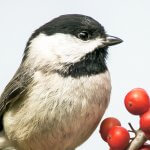
Help support ABC's conservation mission!
In 2016, the conservation consortium Partners in Flight reported that the Carolina Chickadee population had undergone an estimated 11-percent decline from 1970 to 2014. Factors likely contributing to this slow but steady drop include habitat loss as well as the proliferation of invasive nonnative plants that crowd out or smother trees and shrubs important to this bird and its caterpillar food sources. Locally, overzealous pruning of street or backyard trees may cut supplies of natural cavities, reducing the number of available nest sites.
If you live in the Southeast, you can help suburban Carolina Chickadees in several ways: First, you can plant or protect native trees that host many types of caterpillars. These include species of oak, cherry, and willow. Second, avoid using pesticides in your yard, ensuring your property is a safe zone not only for birds and caterpillars, but also bees and many other beneficial species. Third, ensure cats stay indoors, keeping chickadees and other birds safe from their most formidable nonnative predator. Fourth, take steps to reduce the chances of bird collisions with glass.
Get Involved
Policies enacted by the U.S. Congress and federal agencies, such as the U.S. Fish and Wildlife Service, have a huge impact on U.S. birds. You can help shape these rules for the better by telling lawmakers to prioritize birds, bird habitat, and bird-friendly measures. To get started, visit ABC's Action Center.
Living a bird-friendly life can have an immediate impact on the birds around you. Doing so can be as easy as adding native plants to your garden, avoiding pesticides, and keeping cats indoors. To learn more, visit our Bird-Friendly Life page.
American Bird Conservancy and our Migratory Bird Joint Venture partners have improved conservation management on more than 8.5 million acres of U.S. bird habitat — an area larger than the state of Maryland — over the last ten years. This is a monumental undertaking, requiring the support of many, and you can help by making a gift today.







































